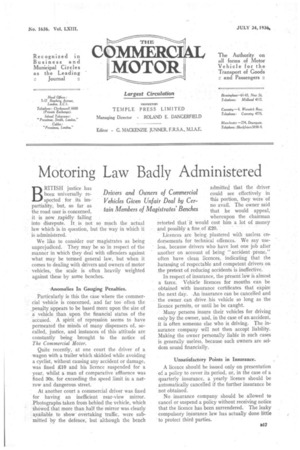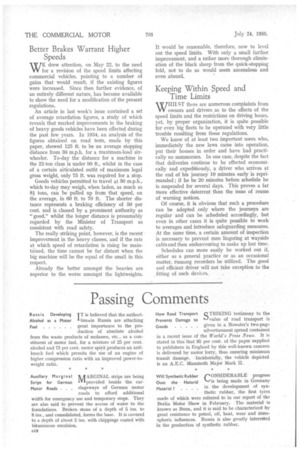Motoring Law Badly Administered
Page 31

Page 32

If you've noticed an error in this article please click here to report it so we can fix it.
DRITISH justice has been universally respected S for . its impartiality, but, so far as the road user is concerned, it is now rapidly falling into disrepute. It . is not so much the actual law which is in question, but the way in which it is administered.
We like to consider our magistrates as being unprejudiced. They may be so in respect of the manner in which they deal with offenders against what may be termed general law, but when it comes to dealing with drivers and owners of motor vehicles, the scale is often heavily weighted against these by some benches.
Anomalies In Gauging Penalties.
Particularly is this the case where the commercial vehicle is Concerned, and far too often the ,penalty appears to be based more upon the size of vehicle than upoa the financial status of the acCused. A spirit of repression seems to have permeated the minds of many dispensers of, socalled, justice, and instances of this attitude are constantly being brought to the notice of The Commercial Motor.
Quite recently, at one court the driver of a wagon with a trailer which skidded while avoiding a cyclist, without causing any accident or damage, was fined 210 and his licence suspended for a year, whilst a man of comparative affluence was fined 30s. for exceeding the speed limit in a narrow and dangerous street.
At another court a commercial driver was fined for having an inefficient rear-view mirror. Photographs taken from behind the vehicle, which showed that more than half the mirror was clearly available to show overtaking traffic, were submitted by• the defence, but although the bench admitted that the driver could see effectively in this portion, they were of no avail. The owner said that he would appeal, whereupon the chairman retorted that it Would cost him a lot of money and possibly a fine of £20.
Licences are being plastered with useless endorsements for technical offences. We say useless, because drivers who have lost one job after another, on account of being "accident prone," often have clean licences, indicating that the harassing of respectable and competent drivers on the pretext of reducing accidents is ineffective.
In respect of insurance, the present law is almost a farce. Vehicle licences for months can be obtained with insurance certificates that expire the next day. An insurance can be cancelled and the owner can drive his vehicle so long as the licence permits, or until he be caught.
Many persons insure their vehicles for driving only by the owner, and, in the case of an accident, it is often someone else who is driving. The insurance company will not then accept liability. Making the owner personally liable in such cases is generally useless, because such owners are seldom sound financially.
Unsatisfactory Points in Insurance.
A licence should be issued only on presentation of a policy to cover its period, or, in the case of a quarterly insurance, a yearly licence should be automatically cancelled if the further insurance be not obtained.
No insurance company should be allowed to cancel or suspend a policy without receiving notice that the licence has been surrendered. The leaky compulsory insurance law has actually done little to protect third parties. Better Brakes Warrant Higher Speeds WE drew attention, on May 22, to the need for a revision of the speed limits affecting commercial vehicles, pointing to a number of gains that would result, if the existing figures were increased. Since then further evidence, of an entirely different nature, has become available to show the need for a modification of the present regulations.. An article in last week's issue contained a set of average retardation figures, a study of which reveals that marked improvements in the braking of heavy goods vehicles have been effected during the past few years. In 1934, an analysis of the figures obtained on road tests, made by this paper, showed 125 ft. to be an average stopping distance from 30 m.p.h. for a maximum-load sixwheeler. To-day the distance for a machine in the 22-ton class is under 90 ft., whilst in the case of a certain aiticulated outfit of maximum legal gross weight, only 75 ft. was required for a stop. Goods vehicles permitted to travel at 30 m.p.h., which to-day may weigh, when laden, as much as 81 tons, can be pulled up from that speed, on the average, in 60 ft. to 70 ft. The shorter distance represents a braking efficiency of 50 per cent, and is classed by a prominent authority as "good," whilst the longer distance is presumably regarded by the Minister of Transport as consistent with road safety. The really striking point, however, is the recent improvement in the heavy classes, and if the rate at which speed of retardation is rising be maintained, the time cannot be far distant when the big machine will be the equal of the small in this respect. Already the better amongst the heavies are superior to the worse amongst the lightweights. It would be reasonable, therefore, now to level out the speed limits. With only a small further improvement, and a rather more thorough elimination of the black sheep from the quick-stopping fold, not to do so would seem anomalous and even absurd.
Keeping Within Speed and Time Limits WHILST there are numerous complaints from owners and drivers as to the effects of the speed limits and the restrictions on driving hours, yet, by proper organization, it is quite possible for even big fleets to be operated with very little trouble resulting from these regulations. We know of at least two important users who, immediately the new laws came into operation, put their houses in order and have had practically no summonses. In one case, despite the fact that deliveries continue to be effected economically and expeditiously, a driver who arrives at the end of his journey 10 minutes early is reprimanded; if he be 20 minutes before schedule he is suspended for several days. This proves a far more effective deterrent than the issue of reams of warning notices. Of course, it is obvious that such a procedure can be adopted only where the journeys are regular and can be scheduled accordingly, but even in other cases it is quite possible to work to averages and introduce safeguarding measures. At the same time, a certain amount of inspection is necessary to prevent men lingering at wayside cafés and then endeavouring to make up lost time. Schedules can more easily be worked out if, either as a general practice or as an occasional matter, running recorders be utilized. The good and efficient driver will not take exception to the fitting of such devki.s.




























































































